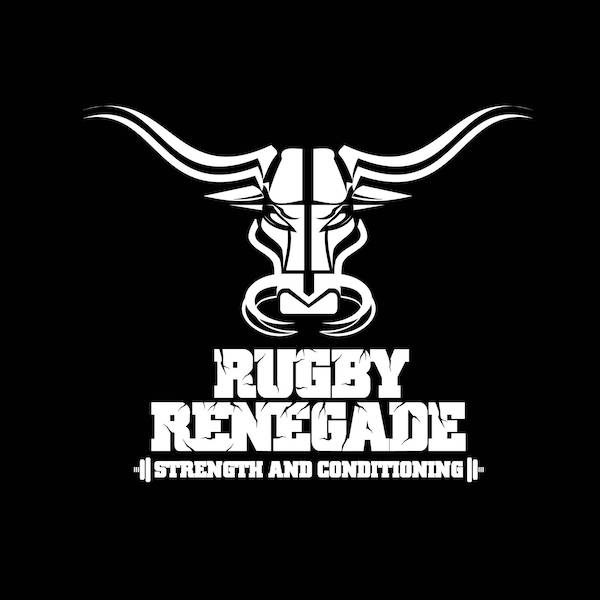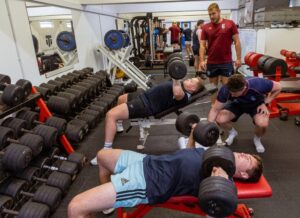What is Velocity Based Training
Velocity based training has been used for years in elite sport but has become possible for everyday athletes with the advent of smartphones and more affordable dynamometers. Essentially by using such devices you can measure the speed at which you perform exercises and calculate power and other useful metrics.
Why use Velocity Based Training
As regular Rugby Renegade readers will know Maximal Strength has a huge benefit to rugby performance, but once you get to good level of strength you will need to focus on more explosive methods of training. This is where velocity based training comes in. Now the emphasis is less o the load lifted and more on the speed of movement and increasing that speed. Remember in a match it’s always the player who performs the skill first who has the advantage!
VBT Methods
Monitoring Velocity
Obviously as we know one of the goals of training is to push our force-velocity curve up and to the right so we can produce more force faster. When we are training we can track how much force we are producing by monitoring 1RM, but how do we know if we’re getting faster also? Velocity based training obviously!
The us of velocity measuring devices during power training gives us objective feedback which will improve the training by increasing focus and competition and also allow us to track performance improvements in terms of speed.
Programming with Velocity
Normally programming just uses load based off 1RM’s and sets and reps. Velocity based training can provide another tool to use to guide training. If we know what speeds certain exercises need to be performed at to develop a certain quality (strength-speed, speed-strength) we can prescribe speeds that the athlete needs to be training at.
For example you could have Jump Squats programmed for 5 sets of 3 reps @ >1.0m/s. This means the athletes will use whatever load allows them to hit that speed rather than guessing based on research of % of 1RM. It also allows the athlete to use the load they can move on that day based on their readiness which leads to our next method…
Auto Regulation of Training
Our readiness to train and perform is based on multiple factors that even the best coach can’t totally factor in and program for. We have all experienced days when you should be ready but feel sluggish and days when you imagine you’ll be exhausted but have set a new pr (well i hope so anyway). The need to auto-regulate our training is one of the benefits of VBT and you have several ways to do it.
The above example of prescribing a speed to an exercise is perfect as on days when you’re readiness is high you will lift more weight at said speed and other days you will use lighter weights. This way on days when you feel good you can train harder and days when you don’t you get almost active recovery. You get a more optimal training stimulus each session and multiplied over numerous sessions and blocks of training that will have a huge effect.
Measuring Proximity to Failure
This is another technique that you can use for auto-regulation. If you know the speed at which you will fail on an exercise you can set thresholds for when to stop a set. For instance in the box squat we know that anything slower than 0.35m/s chances are you will fail the lift and/or technique will be sub optimal.
If you’re doing straight sets with the same weight you can use this for each set and stop just short of failure or even set a lower threshold so you know all reps are performed with good technique and explosive. If you are increasing the load each set then when you get to a set where you can’t keep all reps over target you know that is your top weight for the day.
Drop Off
This is a really fun technique to use and is great for power endurance. I’ll give you a specific example but you can manipulate it for different goals. We’ll use Jump Squats at 30% 1RM Squat. Basically you need to set your velocity device to alert you when your rep speed drops below 90% of your best effort and perform as many maximum explosive reps as possible. When you drop below 90% finish the set. Again it takes into account auto-regulation as on some days you’ll perform more reps and other less.
All these Velocity Based Training techniques help greatly with two things; Increasing/focusing intent to move as explosively as possible and building competition whether it’s with yourself or your teammates.
Velocity Based Training Devices
There a heaps of good velocity measuring devices out there and it’s a growing market too so no doubt there will be more becoming available in the near future and hopefully more affordable. There seem to be two main types; ones that have wire that connects to the bar or ones that connect directly to the bar/body/implement you’r lifting. From what we’ve seen the cable ones tend to be more accurate but as they have moving parts need more maintenance and there is more chance of damage and need for repairs.
The common ones we’ve used and seen become more popular are the Tendo Unit, Gym Aware and Train With Push Band. We would suggest ones that give you feedback each rep rather than at the end of the set so as there is no delay in feedback and to drive the competitive element.
Irrespective make sure you do your own research and find one that is accurate and practical to your needs.
Pitfalls of Velocity Based Training
As with anything it isn’t all new pr’s and bigger muscles!! The main downside of velocity based training we’ve seen is compromised exercise technique. Obviously the intent to move explosively is a massive benefit but unfortunately chasing the speed numbers can lead to athletes changing technique or cheating! Also as a coach you sometimes find yourself just looking at the velocity measure and not making sure the technique is still correct. For this reason we’ve moved away from using VBT with technical exercises like olympic lifts and would want all athletes to have a good background with all exercises before throwing them into an explosive protocol.
Wrap Up
Velocity Based Training can be a hugely effective addition to the training program of athletes with a good strength and technique base. It provides some novel training approaches that will help rugby players develop explosive power and auto-regulate their training easily, effectively and in a stimulating environment.




